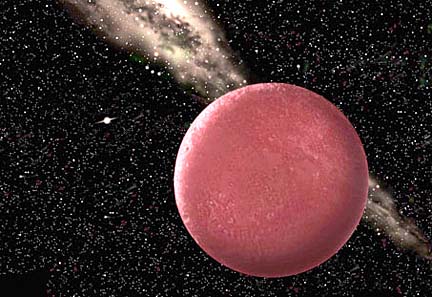
|
New planet found
An object similar to Pluto
is found by a team that
includes a Gemini astronomer
HILO » A new planet spinning around the sun, the 10th in the solar system, has been discovered by a team of astronomers, including one from the Gemini Observatory on Mauna Kea.
Although other small, planetlike objects have been discovered beyond the orbit of Pluto, the new object is the first true planet to be discovered in the solar system since astronomer Clyde Tombaugh sighted Pluto in 1930.
The discovery of a planet-size body so far from the sun, as much as 97.6 times the distance from the sun to Earth, increases the chances that there are more planets far out on the edge of the solar system waiting to be discovered, Gemini's Chad Trujillo said.
Comparable in size to Pluto, the new object was first seen in images made on a small telescope at Mount Palomar, Calif., in 2003, but its motion through the sky was not detected until December, a Gemini statement said.
The discovery was made using the Samuel Oschin telescope with a 48-inch mirror, tiny compared with the 26-foot mirror of Gemini. A three-man team, headed by Mike Brown of the California Institute of Technology and including David Rabinowitz of Yale as well as Trujillo, was searching for near-Earth asteroids.
The technique is the same as the one Tombaugh used to find Pluto: Make an image, compare it with another one made later and see if anything has moved. Unlike Tombaugh, astronomers now use computers to make the comparison instead of their naked eye.
After the discovery, Trujillo used the Gemini North telescope on Mauna Kea to analyze infrared light from the planet, thereby drawing conclusions about its surface.
The planet is covered with frozen methane, Trujillo said. On Earth, methane is a gas, but it freezes to ice on the planet, which is so distant from the sun that its surface temperature is only about 30 degrees above absolute zero.
A name for the planet has been proposed, but until it is approved by the International Astronomical Union, the object is called 2003 UB313.
While more distant than Pluto, the new planet is similar to its closest counterpart in several respects.
Both are smaller than Earth's moon. Pluto has a diameter of 1,485 miles compared with the moon's diameter of 2,157 miles. The new planet is at least as large as Pluto and possibly a little bigger, Trujillo said. The size of the planet is figured from the amount of light reflected by it, but astronomers are not exactly sure how reflective its surface is.
It could be a small, bright object or a somewhat larger, darker object, Trujillo said.
Knowing that the surface is covered with frozen methane helps calculate the reflectivity, but comparison with Pluto's reflectivity is uncertain because Pluto also has frozen nitrogen on its surface.
Astronomers measure the distance of planets in comparison with the distance of Earth from the sun.
While other planets have fairly circular orbits, Pluto has an odd, elliptical orbit that takes it as close as 29.6 times the Earth-sun distance and as far as 49.3 times the distance.
The new planet moves as close as 37.9 times the earth-sun distance and as far as 97.6 times the distance.
The numbers mean Pluto sometimes comes inside the orbit of Neptune and that the new planet sometimes comes inside Pluto's orbit. The new planet takes 557 years to go around the sun, compared with 248 years for Pluto.
On Thursday, Brown's team and another in Spain announced the discovery of a "miniplanet" designated 2003 EL61. Earlier they announced finding objects named Quaoar, 800 miles in diameter, and Varuna, 560 miles in diameter, on the edge of the solar system.
www.gemini.edu
E-mail to City Desk
[News] [Business] [Features] [Sports] [Editorial] [Do It Electric!]
[Classified Ads] [Search] [Subscribe] [Info] [Letter to Editor]
[Feedback]
